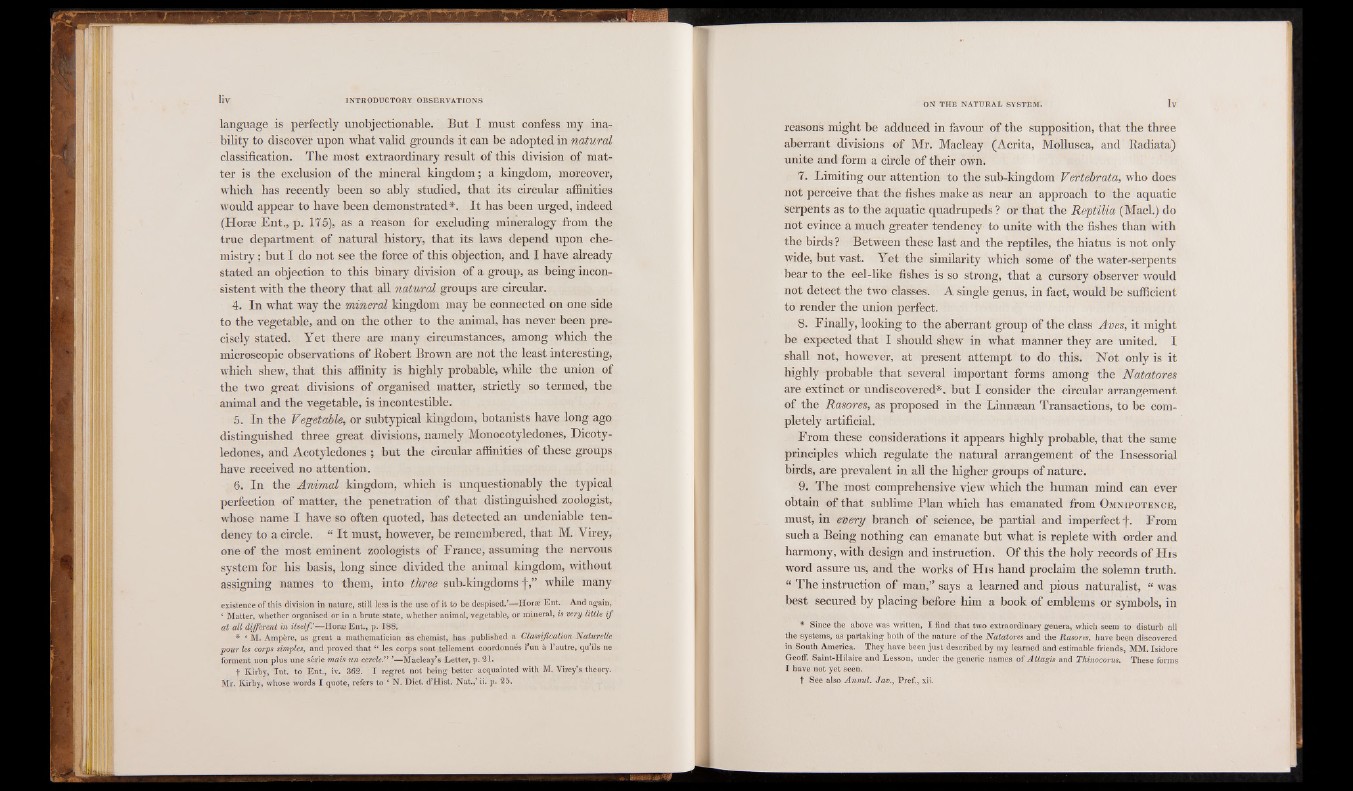
language is perfectly unobjectionable. But I must confess my inability
to discover upon what valid grounds it can be adopted in natural
classification. The most extraordinary result of this division of matter
is the exclusion of the mineral kingdom ; a kingdom, moreover,
which has recently been so ably studied, that its circular affinities
would appear to have been demonstrated*. It has been urged, indeed
(Horæ Ent., p. 175), as a reason for excluding mineralogy from the
true department of natural history, that its laws depend upon chemistry
; but I do not see the force of this objection, and I have already
stated an objection to this binary division of a group, as being inconsistent
with the theory that all natural groups are circular.
4. In what way the mineral kingdom may be connected on one side
to the vegetable, and on the other to the animal, has never been precisely
stated. Yet there are many circumstances, among which the
microscopic observations of .Robert Brown are not the least interesting,
which shew, that this affinity is highly probable, while the union of
the two great divisions of organised matter, strictly so termed, the
animal and the vegetable, is incontestible.
5. In the Vegetable, or subtypical kingdom, botanists have long ago
distinguished three great divisions, namely Monocotyledones, Dicotylédones,
and Acotyledones ; but the circular affinities of these groups
have received no attention.
6. In the Animal kingdom, which is unquestionably the typical
perfection of matter, the penetration of that distinguished zoologist,
whose name I have so often quoted, has detected an undeniable tendency
to a circle. “ It must, however, be remembered, that M. Virey,
one of the most eminent zoologists of France, assuming the nervous
system for his basis, long since divided the animal kingdom, without
assigning names to them, into three sub-kingdoms j-,” while many
existence of this division in nature, still less is the use of it to be despised.’—Horæ Ent. And again,
‘ Matter, whether organised or in a brute state, whether animal, vegetable, or mineral, is very little if
at all different in itself.'—Horæ Ent., p. 188.
* ‘ M. Ampère, as great a mathematician as chemist, has published a Classification Naturelle
pour les corps simples, and proved that “ les corps sont tellement coordonnés 1 un à l’autre, qu ils ne
forment non plus une série mais un cercle.” ’—Mâcleay’s Letter, p. 21.
t Kirby, Int. to Ent., iv. 362. I regret not being better acquainted with M. Virey’s theory.
Mr. Kirby, whose words I quote, refers to ‘ N. Diet. d’Hist. Nat.,’ ii. p. 25.
reasons might be adduced in favour of the supposition, that the three
aberrant divisions of Mr. Macleay (Acrita, Mollusca, and Radiata)
unite and form a circle of their own.
7. Limiting our attention to the sub-kingdom Vertebrata, who does
not perceive that the fishes make as near an approach to the aquatic
serpents as to the aquatic quadrupeds ? or that the Reptilia (Macl.) do
not evince a much greater tendency to unite with the fishes than with
the birds ? Between these last and the reptiles, the hiatus is not only
wide, but vast. Yet the similarity which some of the water-serpents
bear to the eel-like fishes is so strong, that a cursory observer would
not detect the two classes. A single genus, in fact, would be sufficient
to render the union perfect.
8. Finally, looking to the aberrant group of the class Aves, it might
be expected that I should shew in what manner they are united. I
shall not, however, at present attempt to do this. Not only is it
highly probable that several important forms among the Natatores
are extinct or undiscovered*, but I consider the circular arrangement
of the Rasores, as proposed in the Linnaean Transactions, to be completely
artificial.
From these considerations it appears highly probable, that the same
principles which regulate the natural arrangement of the Insessorial
birds, are prevalent in all the higher groups of nature.
9. The most comprehensive view which the human mind can ever
obtain of that sublime Plan which has emanated from O m n ip o t e n c e ,
must, in every branch of science, be partial and imperfect f. From
such a Being nothing can emanate but what is replete with order and
harmony, with design and instruction. Of this the holy records of His
word assure us, and the works of His hand proclaim the solemn truth.
“ The instruction of man,” says a learned and pious naturalist, “ was
best secured by placing before him a book of emblems or symbols, in
* Since the above was written, I find that two extraordinary genera, which seem to disturb all
the systems, as partaking both of the nature of the Natatores and the Rasores, have been discovered
in South America. They have been just described by my learned and estimable friends, MM. Isidore
Geoff. Saint-Hilaire and Lesson, under the generic names of Attagis and Thinocorus. These forms
I have not yet seen.
t See also Annul. Jav., Pref., xii.